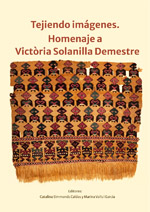Textiles Studies
Date of this Version
2023
Document Type
Article
Citation
doi: 10.32873/unl.dc.zea.1410
Publicado en Tejiendo imágenes. Homenaje a Victòria Solanilla Demestre, ed. C. Simmons Caldas y M. Valls i García (Lincoln, Nebraska: Zea Books, 2023). http://digitalcommons.unl.edu/tihvsd
Abstract
Resumen: Esta investigación transdisciplinaria, que abarca estudios de arqueología, antropología, semiótica y estética, se propone analizar la iconografía de «la llama» en el arte Tiwanaku. Múltiples representaciones de camélidos se encuentran pintadas, grabadas y tejidas en diferentes tipologías de materiales ceremoniales tiwanakotas, reflejando su importancia en la cosmovisión de esta antigua cultura. A través de este estudio iconográfico e iconológico se pretende mostraría como las imágenes de camélidos estaban incluidas en un conjunto de símbolos mágico-religiosos y de poder, manifestando el rol central que estos animales tuvieron para el desarrollo económico y cultural de la sociedad tiwanakota. Todas las imágenes estudiadas presentan unos rasgos comunes entre ellas, revelando la existencia de unas normas artísticosagradas de composición. El icono de la llama, reproducido de manera constante junto a unas flores y a unas caras, indicaría su relación con algunos rituales específicos, y mostraría su nexo con un culto a la fertilidad.
Abstract: This transdisciplinary research, which encompasses studies on archaeology, anthropology, semiotics and aesthetics, aims to analyze the iconography of «the llama» in Tiwanaku art. Multiple representations of camelids are painted, engraved and woven in different types of Tiwanaku ceremonial materials, reflecting their importance in the worldview of this ancient culture. This iconographic and iconological study shows how the images of camelids were included in a set of magicalreligious and power symbols, demonstrating the central role that these animals played in the economic and cultural development of Tiwanaku society. All the images studied have some common features, revealing the existence of some artistic-sacred rules of composition. The llama icon, constantly reproduced next to flowers and faces, would indicate its relationship with some specific rituals, and show its connection with a fertility cult.
Included in
American Material Culture Commons, History of Art, Architecture, and Archaeology Commons, Indigenous Studies Commons, Latin American History Commons, Native American Studies Commons, Other History Commons



Comments
Copyright © 2023 Elisa Cont